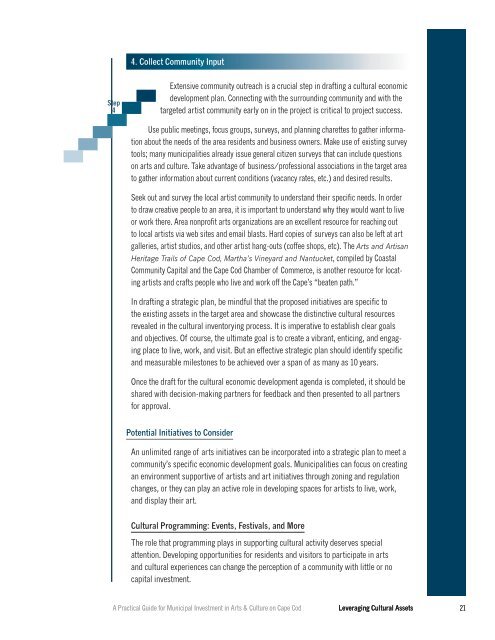Leveraging Cultural Assets for Economic Development - Cape Cod ...
Leveraging Cultural Assets for Economic Development - Cape Cod ...
Leveraging Cultural Assets for Economic Development - Cape Cod ...
- No tags were found...
Create successful ePaper yourself
Turn your PDF publications into a flip-book with our unique Google optimized e-Paper software.
4. Collect Community InputStep4Extensive community outreach is a crucial step in drafting a cultural economicdevelopment plan. Connecting with the surrounding community and with thetargeted artist community early on in the project is critical to project success.Use public meetings, focus groups, surveys, and planning charettes to gather in<strong>for</strong>mationabout the needs of the area residents and business owners. Make use of existing surveytools; many municipalities already issue general citizen surveys that can include questionson arts and culture. Take advantage of business/professional associations in the target areato gather in<strong>for</strong>mation about current conditions (vacancy rates, etc.) and desired results.Seek out and survey the local artist community to understand their specific needs. In orderto draw creative people to an area, it is important to understand why they would want to liveor work there. Area nonprofit arts organizations are an excellent resource <strong>for</strong> reaching outto local artists via web sites and email blasts. Hard copies of surveys can also be left at artgalleries, artist studios, and other artist hang-outs (coffee shops, etc). The Arts and ArtisanHeritage Trails of <strong>Cape</strong> <strong>Cod</strong>, Martha’s Vineyard and Nantucket, compiled by CoastalCommunity Capital and the <strong>Cape</strong> <strong>Cod</strong> Chamber of Commerce, is another resource <strong>for</strong> locatingartists and crafts people who live and work off the <strong>Cape</strong>’s “beaten path.”In drafting a strategic plan, be mindful that the proposed initiatives are specific tothe existing assets in the target area and showcase the distinctive cultural resourcesrevealed in the cultural inventorying process. It is imperative to establish clear goalsand objectives. Of course, the ultimate goal is to create a vibrant, enticing, and engagingplace to live, work, and visit. But an effective strategic plan should identify specificand measurable milestones to be achieved over a span of as many as 10 years.Once the draft <strong>for</strong> the cultural economic development agenda is completed, it should beshared with decision-making partners <strong>for</strong> feedback and then presented to all partners<strong>for</strong> approval.Potential Initiatives to ConsiderAn unlimited range of arts initiatives can be incorporated into a strategic plan to meet acommunity’s specific economic development goals. Municipalities can focus on creatingan environment supportive of artists and art initiatives through zoning and regulationchanges, or they can play an active role in developing spaces <strong>for</strong> artists to live, work,and display their art.<strong>Cultural</strong> Programming: Events, Festivals, and MoreThe role that programming plays in supporting cultural activity deserves specialattention. Developing opportunities <strong>for</strong> residents and visitors to participate in artsand cultural experiences can change the perception of a community with little or nocapital investment.A Practical Guide <strong>for</strong> Municipal Investment in Arts & Culture on <strong>Cape</strong> <strong>Cod</strong> <strong>Leveraging</strong> <strong>Cultural</strong> <strong>Assets</strong> 21
















